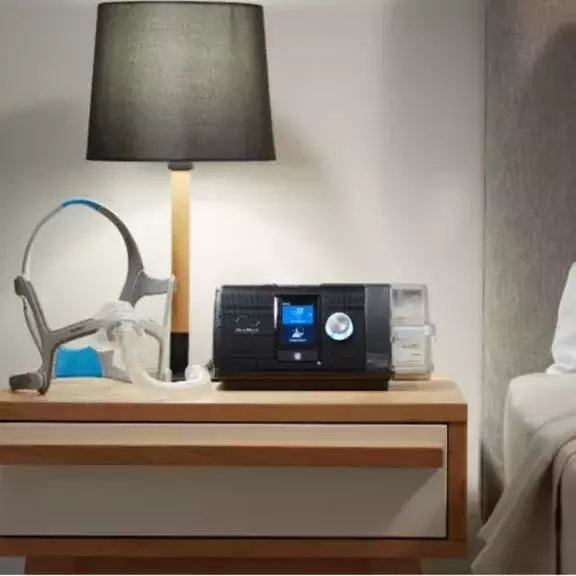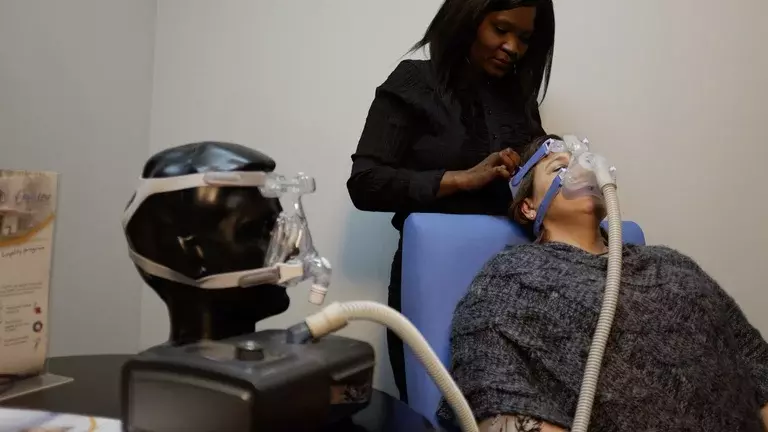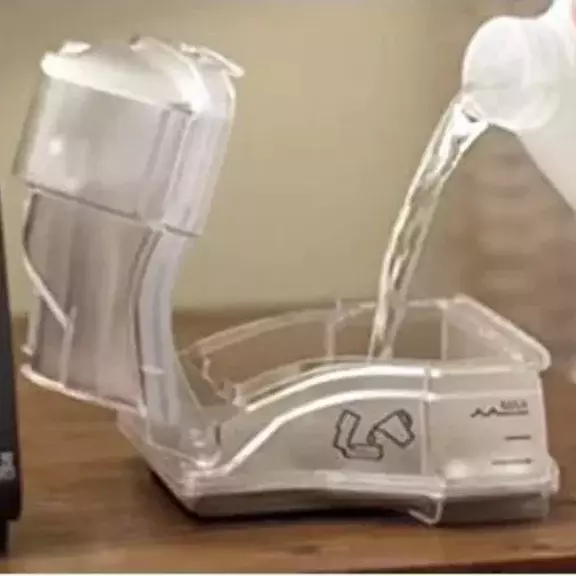Learn how to properly care for your CPAP equipment
It is important to maintain your equipment regularly to maximize the benefits of your treatment.
Regular maintenance of your Continuous Positive Airway Pressure (CPAP) device will also help to prevent contamination, thus reducing the risk of infections, as well as odor and general wear and tear.
We recommend that you clean your mask every day as it is in direct contact with your skin. This way, your mask will remain free of bacteria and mold, reducing your overall risk of infection. (1, 2)
After removing the support, clean the mask and its components (cushion, frame, elbow…):
- Every morning ; (7-11)
- In warm water (approximately 30 °C); (8-11)
- With mild soap or a mild soap (such as white vinegar or liquid soap). Do not use bleach or solutions that contain alcohol; (9-12)
- Another option is to take the mask to the shower with you;
- Clean your mask backing in exactly the same way, but at weekly or monthly intervals, depending on how quickly you get dirty (you sweat more in the summer, for example); (10, 11)
- Allow the components to dry completely outdoors, out of direct sunlight; (8, 10)
- Check the working condition of your mask and support and replace any damaged components if necessary. (8, 9)
In addition to preventing infections, regularly cleaning your mask will help:
- Prevent air leaks, as a clean mask will have a superior seal.
- Extend the life of your mask and support and keep them in good working order;
- The above information is provided for general information purposes only. See your User Guide for more specific information about caring for your CPAP device.
Here are some tips to help you maintain your CPAP device:
- Before cleaning the device, make sure that it is turned off, unplugging the power cord from the socket; (1, 2, 4, 5)
- During cleaning, take the opportunity to check the general condition of the CPAP and its components;
- Do not use harsh detergents, solutions that contain alcohol, or the abrasive side of a sponge to clean your CPAP. (4, 5)
Weekly cleaning (every Saturday, for example)
Air filter (if reusable or non-disposable) (1,2,4) :
- Remove the washable air filter from the equipment and wash it in warm water with a mild soap (a few drops of diluted liquid soap, for example);
- Rinse it thoroughly with clean water to remove all residues;
- Allow it to air dry, out of direct sunlight, before putting it back on the CPAP. Replace the filter if it has punctures, is broken or shows any other sign of damage;
- Change the filter according to the maintenance schedule recommended by your CPAP manufacturer.
Tubes (1,2,3,5) :
- Disconnect the CPAP tube from your mask;
- Clean it with warm water using a mild soap;
- Rinse it thoroughly with clean water to remove all residues;
- Hang the tube until dry (on the back of a chair, for example, with both ends facing down), out of direct sunlight, before connecting it to the CPAP;
- Replace the tube if it shows any signs of damage;
- Change the tube according to the maintenance schedule recommended by your CPAP manufacturer.
Monthly cleaning (every first Saturday of the month, for example)
Monthly cleaning (every first Saturday of the month, for example) :
CPAP (1,2,4,5) :
- Clean the outside of the equipment with a soft, slightly damp cloth.
- Then dry it with a dry cloth.
- On average, CPAP machines usually last 5 years. (4)
How to maintain and clean your humidifier?
Among CPAP care, it is important to regularly maintain your humidifier. This will help to prevent contamination, thus reducing the risk of infections, as well as odors and general wear and tear.
Check out some useful tips to help you carry out your daily cleaning routine
- Before cleaning the device, make sure it is turned off by unplugging the power cord from the socket; (13, 14, 16, 17, 18)
- During cleaning, take this opportunity to check the general condition of the CPAP and its components;
- Do not use harsh detergent solutions that contain alcohol or the abrasive side of a sponge to clean your humidifier; (16, 17)
- Some humidifier reservoirs are dishwasher-safe, with a maximum temperature of 65°C. (14-18)
Daily cleaning (14-18) :
- Every morning, remove the reservoir from the device and drain the water;
- Rinse the reservoir and let it dry in the open air, out of direct sunlight;
- Once dry, place the humidifier back in the CPAP unit.
Weekly cleaning (every Saturday, for example) (14-17) :
- Remove the reservoir and drain the water;
- Carry out the usual routine of daily cleaning;
- After that, you can soak the water tank in a mixture of water and vinegar (1 part white vinegar to 10 parts water) for 10 minutes to prevent mold and remove any scale; (15, 16, 17)
- Rinse thoroughly with clean water and allow to air dry, out of direct sunlight.
The above content is provided for general information purposes only. Please refer to the User's Guide if you need any specific information about your humidifier.
Clean your equipment and components regularly to prevent the risk of infections and air leaks.
References
1 . DreamStation User Manual Bipap autoSV, Philips
2 . DreamStation User Manual, Philips
3 .AirSense User Manual 10 Autoset, Resmed
4. S.BOX User Manual, Sefam
5. User Manual and Maintenance, ICON +, Fisher&Paykel
6 . Kairin app
7 . Schnirman R. A case of legionella pneumonia caused by home use of continuous positive airway pressure. SAGE Open Med Case Rep. December 5, 2017;5:2050313X17744981
8 . AirFit™ (ResMed)
9 . Manuel utilisateur des masques des games EasyFit® (Devilbiss Healthcare)
10. Manual utilisateur des masques des games iVolve™ (BMC)
11 . Manual utilisateur des masques des games Respironics™ (Philips)
12 . Kairin app
13 .User's Manual, DreamStation BiPAP autoSV, Philips
14 .User's Manual, DreamStation Heated Humidifier, Philips
15 .User's Manual, AirSense 10 AutoSet, ResMed
16 .Patient's Manual, S.BOX, Sefam
17 . Use and Maintenance, ICON +, Fisher&Paykel
18 .User's Guide, H5i Heated Humidifier, ResMed
19 . iVolve™ N2 Nasal Mask (BMC) User Guide
20 . AirFit™ N20 Nasal Mask User Guide (ResMed)
21. EasyFit™ SilkGel Full Face Mask User Guide (DeVilbiss Healthcare)
22 . DreamWear Nasal Mask User Guide (Philips)
23 . AirSense™ 10 User Guide (ResMed)
24 . DreamStation™ User Guide BiPAP autoSV (Philips)
25 . S.Box™ User Guide (Sefam)
26 . BLUE™ User Guide (DeVilbiss Healthcare)
2 . DreamStation User Manual, Philips
3 .AirSense User Manual 10 Autoset, Resmed
4. S.BOX User Manual, Sefam
5. User Manual and Maintenance, ICON +, Fisher&Paykel
6 . Kairin app
7 . Schnirman R. A case of legionella pneumonia caused by home use of continuous positive airway pressure. SAGE Open Med Case Rep. December 5, 2017;5:2050313X17744981
8 . AirFit™ (ResMed)
9 . Manuel utilisateur des masques des games EasyFit® (Devilbiss Healthcare)
10. Manual utilisateur des masques des games iVolve™ (BMC)
11 . Manual utilisateur des masques des games Respironics™ (Philips)
12 . Kairin app
13 .User's Manual, DreamStation BiPAP autoSV, Philips
14 .User's Manual, DreamStation Heated Humidifier, Philips
15 .User's Manual, AirSense 10 AutoSet, ResMed
16 .Patient's Manual, S.BOX, Sefam
17 . Use and Maintenance, ICON +, Fisher&Paykel
18 .User's Guide, H5i Heated Humidifier, ResMed
19 . iVolve™ N2 Nasal Mask (BMC) User Guide
20 . AirFit™ N20 Nasal Mask User Guide (ResMed)
21. EasyFit™ SilkGel Full Face Mask User Guide (DeVilbiss Healthcare)
22 . DreamWear Nasal Mask User Guide (Philips)
23 . AirSense™ 10 User Guide (ResMed)
24 . DreamStation™ User Guide BiPAP autoSV (Philips)
25 . S.Box™ User Guide (Sefam)
26 . BLUE™ User Guide (DeVilbiss Healthcare)


